Alfa rides new Tonale into expanded U.S. presence
Filed under: Weekly test drives, Autos
By John Gilbert
If you’re old enough, you might remember the 1967 movie “The Graduate,” in which a college-aged Dustin Hoffman, Anne Bancroft and the beautiful Katherine Ross became huge stars. But they had to share star billing with a captive 1996 Alfa Romeo Duetto Spider, the 2-seat roadster that carried Benjamin on his assorted escapades.
We all could identify with somebody in that classic coming-of-age movie, and we all were unanimous in wanting an Alfa Romeo.
There is a touch of magic that penetrates your soul when you drive an Alfa, although the Italian company never made it big in the U.S. except in the dreams of anybody who appreciates a fine precision driving machine that practically anticipates your driving impulses. That feeling came back in spades when Alfa created the Giulia sedan and, as a part of owner Fiat just after Chrysler Corporation joined it as a sibling, many new American drivers got a taste of that magic. Same with the following Stelvio, a midsize SUV that handled like a Giulia, which handles like a sports car.
But the overriding concern is that the sensational feeling of driving an Alfa might be offset by the reputation — accurately gained, we must add — of unreliability, when compared to the top German sports sedans.
For 2024, however, there has been an enormous changeover at Alfa Romeo, which now is under the Stellantis banner of ownership — as is Ferrari, Chrysler, Dodge, Ram, Jeep, Fiat, Maserati, Aston Martin, and Alfa Romeo. Under that umbrella, the Tonale is being introduced into the U.S., but not just with the usual new-car hope. Stellanis has pushed Alfa to improve the breed and make the Tonale a model that can come to the U.S. and make serious inroads into the American market.
Almost subtly, Alfa has risen in the JD Power new-car satisfaction and initial quality ratings that are the most trusted in the industry. When I learned that Alfa had risen to the top echelon in those two classifications — ahead of BMW, Mercedes and Audi — it was startling. If Alfa is more dependable and trustworthy than those three stellar marques, that is a dazzling hat trick. With that in its resume, we learn that Stellantis is directing Alfa to send enough Tonales to the U.S. to erase all those old barriers that prevented U.S. consumers from seeking out Alfa vehicles.
What has not been erased from Alfa’s resume is that magical driving experience. I was able to spend a week with a 2024 Tonale up and down the hills of Duluth, up and down the highways up the North Shore of Lake Superior. The steering and precise handling immediately conjured up reflections of the Giulia, which I found to be one of the best-handling sedans every built, right up there with the top BMW sports sedans.
And the luxury touches in the interior add to the image, while the technology is simply off the top of the charts. In this era of moving toward electrification, the Giulia makes a valid statement of taking hybrid technology to new levels of economy and performance, over and above normal gas-engined cars and without any of the range-anxiety that gives pause to car-buyers to adopt all-out electric vehicles.
When I first did a brief drive in various new models at the Midwest Auto Media Association’s spring rally at Road America, I was impressed with both Alfas I drove, but I was unaware of the intricacies of the engineering technology under the hood.
It starts with a surprisingly sprightly 1.3-liter 4-cylinder gas engine, turbocharged, and adds a 15.5 kilowatt-hour battery to power a 90 kilowatt electric motor. Altogether, the system produces 272 horsepower, running through all-wheel drive via a 6-speed automatic. There are various buttons and controls you can activate to stress regenerative braking power back to the battery-pack or to push the gas-engine power, or the joint power of the plug-in hybrid.
The base model is certainly no slouch, with a 2.0-liter 4-cylinder turbo engine and a 9-speed automatic with all-wheel drive, but its more-than-adequate power is left behind by the hybrid powertrain. The battery pack, incidentally, is an advanced-tech unit produced in China, which means its internationally flavored production is 56 percent from Italy (it’s assembled in Pamigliano, Italy), with the transmission from Japan, and the final 12 percent of Chinese origin. We in the U.S. are concerned about falling behind China’s onrushing advantages in battery and EV technology, but Italy is not suffering from the same reluctance.
A subtle little driving advantage is that the steering-wheel shift paddles, normally affixed to the steering wheel’s right and left edges, are tall alloy bars that are affixed to the steering column, instead, so in spirited driving, if you swerve around a sharp corner, you needn’t grope for where on the turned steering while to find those paddles — they’re where they always should be.
On the console and dash, you find different controls. One offers a tightening of the steering and suspension whether you select sport, eco or comfort, and another for whether you want to stress gas, hybrid or EV power. Similarly, you can change the entire format of the instruments, going digital or analog, or giving you speed in a large digital number and other information easily set. I personally prefer the familiar round analog tach and speedometer, with other pertinent information between them.
For all the technology loaded into the Tonale, I was surprised to learn that the vehicle could be obtained for about $45,000, although adding the $1,500 19-inch alloy wheels, a $1,200 full electric moonroof, a $3,000, a $2,000 premium sound package, and a $2,000 advanced active-assist package with various safety alerts and lane-changing devices boosted the test car’s sticker to $55,950.
Still, if JD Power is right, and the Tonale TI e is now higher rated than BMW, Mercedes, Audi and nearly all other worldwide vehicles in initial quality and satisfaction, plus you get high-tech power and fuel economy, and that legendary Alfa handling magic, well, the price is a bargain.
Mainstream Outlander moves upstream
Filed under: Weekly test drives, Autos
By John Gilbert
At a glance, the 2023 Mitsubishi Outlander Ralliart SE is a surprise to your senses. At first, from the front, its uniquely-sculptured hood and fenders encircle the headlight enclosures and make it look a little like a bug-eyed monster with too much mascara.
But don’t worry about the frontal appearance — it grows on you. Even in as short a time as one week, which matches the test-drive span I drove the vehicle, you reach the point where it doesn’t bother y9u anymore, and then you actually start to like it.
Mitsubishi has always been full of surprises in the 50 years it’s been bringing vehicles from Japan into the U.S. for sale, and in retrospect it seems a shame that the company didn’t come in by itself at the same time Honda, Toyota, Nissan, Mazda and Subaru were breaking into the U.S. market. Instead, Mitsubishi hooked up with Chrysler Corporation and in truth pretty much saved Dodge, Plymouth and Chrysler from major struggles.
Slow-learning consumers might have scorned those first Japanese imports, and Chrysler fans might have joined them saying the Dodge Colt subcompact was better than those Japanese competitors, but of course, the Colt was built by Mitsubishi, as was the Plymouth Champ. The Colt also came in a station wagon, and when Japanese competitors discovered the versatility and popularity of minivans, Chrysler held all the aces with the Dodge Caravan and later the Plymouth Voyager and Chrysler Town & Country. Those were company-saving vehicles, but a lot of folks didn’t realize that the main reason for their incredible durability was their amazingly smooth-running 3.0 V6 — built by Mitsubishi.
We could go on, into fun cars like the Eagle Talon and Plymouth Laser versions of Mitsubishi’s Eclipse sporty coupe, or the fantastic Dodge Stealth twin of the Mitsubishi 400 GT. But anyway, Mitsubishi never gained the same popularity or fame it might have had on its own, similar to its elite stature with its MGA television and electronics.
That was all back 50 years or so, while the biggest surprise of the last decade is that Mitsubishi is still hanging in there, building innovative vehicles and engines and fighting a truly uphill battle against the rising tide of technology all over the world. But the Outlander is leading Mitsubishi back to SUV popularity. A dozen years ago, Mitsubishi joined Chrysler for a joint venture with Hyundai, and the South Korean upstart began making a superb 2.4-liter engine that all three companies used — and still use.
A year ago, Mitsubishi restructured the Outlander, putting it on a new platform that is the result of another join engineering venture with Nissan and Renault. It was a brilliant move by Mitsubishi, which was adequate before, but now rides on the same platform as the hugely popular Nissan Rogue, and the new Outlander has a 33 percent improvement in torsional rigidity over its predecessor.
With all the right parts in place, the 2023 Outlander Ralliart SE underwent the refinement of a stunning interior, with impressive instrumentation and the luxury of quilted leather bucket seats, stitched to perfection and willing to house seven occupants in comfort and support, to celebrate the vehicle’s 40th anniversary. Well, for certain four or five of those seven will be comfortable; the third-row seat is mainly for youngsters and will spend most of its life probably folded down to increase storage space.
But at least there is a third row if needed.
Under the hood there is a refined version of that joint-venture 2.4-liter four-cylinder gas engine, and it is coupled to a hybrid system consisting of either of two battery arrangements, one with a single electric motor, or a two-motor deal with the two operating each rear wheel for a combined 248 horsepower instead of 132. The same set-up also boosts the torque figure up to 332 foot-pounds, above the standard 188.
The transmission gives you a “choice” between a CVT (continuously variable transmission) and an 8-speed — by giving you both. The CVT has detents built into its belt to simulate eight different gears, and you get steering wheel paddles to facilitate manual control of shifting.
You also can engage “One-pedal driving,” which uses the regenerative braking from the plug-in hybrid electric power to instantly help control your deceleration. So you can almost eliminate ever using the brake pedal, simply use the gas pedal to go and maintain speed, and when you see a stop ahead, you let off the gas and the Outlander slows down by itself, and will actually come to a compete stop, unless you feel the need to step on the brake to slow more quickly.
For a fully loaded price of about $50,000, the Outlander has about every contemporary feature you might want, and a few others don’t have. For example, the plug-in hybrid will accept a Level 3 high-speed charge station, something rare or not found in other three-row SUVs. You can avoid the plug-in and let the regenerative power do its thing alone, but using both can easily lift you up into the high-mileage elite.
Mitsubishi also puts its stamp on its unique all-wheel-drive system, calling it “S-AWC,” for “super all-wheel control,” using the gas engine for front-wheel power and the electric motors to help the rears keep up. It also enhances cornering, and gives the Outlander near sports-sedan agility.
Similarly, Mitsubishi rounds up all its impressive driving aids and puts them into “Mi-Pilot Assist,” which coordinates adaptive cruise control, lane keeping assist, forward collision warning and mitigation, blind spot warning, lane departure warning and prevention, and rear cross traffic alert. And you can stay in touch with everything the Outlander is doing because it has a 12.3 inch digital information screen.
With the battery electrical power fully charged, you can switch it to drive pure electric, or combine the gas-engine power with the electric motor power to zip onto freeways or into congested traffic. You can use pure electric for 34-40 miles of range, and you can bolster your mileage with judicious use of the traction settings. A knob gives you the choice of power, eco, normal, tarmac, gravel, snow, or mud, and you can easily reach 50 miles per gallon, and even reach 60 mpg.
And all of that while in comfort and health. The air conditioning includes an air purifier, which is the perfect thing in this summer of trying to breathe around the Canadian wildfire smoke wafting down into our airspace.
2023 Genesis G90 sets ultra-luxury standard
Filed under: Weekly test drives, Autos
By John Gilbert
Your first look at a 2023 Genesis G90 may stop you in your tracks for the level of sheer luxury the car emits. In this era where many car-makers are discontinuing cars of all varieties for the sake of SUVs of all shapes and sizes, South Korea’s Hyundai has pulled off a remarkable and surprising new luxury sedan.
General Motors, Ford and what used to be Chrysler Corporation have made more news announcing the discontinuing of new sedans than by introducing new models over the last five years, and while Hyundai has SUVs that fit into every niche, it also is building new sedans, and spectacular ones as well.
And that’s just from the outside, where the distinctive grille and the sleek, autobahn-cruising shape attract you from every angle. After carefully perusing the headlights, with their encased battery of small beam LEDs wrap around both corners, to the silhouette, and back to the gently sloping rear window and trunk lid, the real surprises still are awaiting inside.
That is, if you can get in. The four door handles fit flat into the bodywork, and only if you have the key fob do they pop out for your use as you approach. Once they show themselves, you easily pull on them to open the doors. Closing the doors is easier, because you can merely grab the hand-fitting armrest and pull it shut. But you don’t have to. No, you can push the right button and observe the door closing itself, firmly and securely.
When you reach your destination, a little practice makes getting out easy, too. Without it, you may hunt for a few minutes to locate anything that looks like an inside door release. But it’s there, and when you push the button, the door pops open, all by itself.
Such gadgetry might seem annoying to old-time drivers, who liked it best when everything was simple. But the G90 is no commonplace people hauler. It is an exquisite vehicle that rises above the old term “luxury” sedan to easily qualify as “ultra-luxury sedan.” So if a car has all this luxury built in, it is going to cost you, big time, and the G90 fits that bill, too.
The test G90 I drove for a week was gleaming metallic white pearls which allows the black grille and blackened alloy wheels to stand out. Its base price is #98,700, and as-tested, this one stickered for $101,295.
That’s a lot of money for any car, especially one not made by Mercedes, BMW or Audi, or Lexus, but the Genesis G90 actually layers on the luxury and high-tech features to out-German the top models of those tradition German luxury car leaders, as well as to tackle Toyota’s top Lexus luxury cars.
Since bursting on the mainstream sedan scene just over a decade ago, Hyundai — and its adopted partner kia — have risen steadily to the top in quality and performance to match its similarly rising levels of refinement and durability.
Hyundai brought out the Genesis as its top model in 2015, and after refining that original model it decided to split Genesis off into its own bracket, for better focus on challenging the top luxury autos in the industry.
The last model was very good, with a G90 that was similar to but larger than the G80 sedan, and those two spun off some very impressive personal SUVs like the GV60, GV70, GV80 and GV90.
Powering the previous G90 was the very good duo of the 3.3 V6 or the high-tech DOHC Tau V8, which produced tremendous power. But Hyundai has chosen to replace the V8 in the car with a twin-turbocharged 3.6 V6 in base form, and a twin-supercharged version of the high-tech V6 that produces 409 horsepower and 405 foot-pounds of torque. That’s slightly less horsepower, but more torque at the same time, peaking at low RPMs to provide maximum towing and pulling power.
Coupled with the Hyundai-built 8-speed automatic, rear air suspension and adaptive rear-wheel steering, hammering the G90 through a tight turn provides a new definition of sports sedan. All those features work so well integrated with Hyundai’s top-level safety controls, such as its unexcelled lane-departure and lane-centering precision that are a joy to experience.
This is not a lightweight midsize or compact that you can hurl around on an autocross course on weekends, but it does handle convincingly as though it might like to try it.
The immaculate stitching and attention to fit and finish details inside add to the whole picture, but any family with growing kids know they all clamor to sit in the front passenger seat whenever you head for the shopping center or playground. Well, be prepared for a change in attitude with the G90, because everybody — kids, adults and grandparents — will clamor to sit in the right rear.
You climb inside and realize the seat itself is something special, then you start fiddling with the controls and learn how to raise the footres
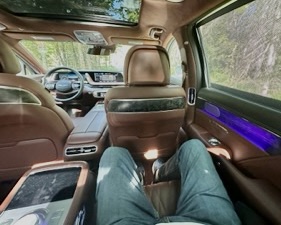
Right rear seat is of first-class jetliner stature, with recline, massage, footrest, and ambient-lighting features..
t as you slightly recline the seat back. You also have sunshades on the rear window and side windows, and you have your own controls for the climate control and solitude. Then you can ask the driver to please select “chauffeur” on the drive control switch, which softens the rear suspension just slightly via the air shocks for a more luxurious ride.
I think the engineers were wise to build in the feel and controls of a top-flight sports sedan rather than a big-screen dominated luxury boat, because no matter how much luxury you might want, when it comes to driving you still want a precise, good-handling sporty-sedan flair to anticipate your every instinct and translate them into action.
I have a couple of concerns about the G90 — which overwhelmed the Motor Trend staff as it was selecting the G90 as its 2023 Car of the Year — and it has to do with our driving climate in Duluth, Minnesota, where I live. Last winter, we broke the all-time records for snow and ice storms and accumulation, and all vehicles were challenged by such weather. True, the heated seats and auto-start can handle most of those conditions, but we have our extremes.
For example, it’s fun to show off the fancy receding door handles, but I need to know if, after standing up to a 20-inch snowfall during an ice-storm blizzard in January, will those door handles open at the slight influence of approaching with the key fob? My guess is that you might need another bit of training on how to open those doors if they are encased in 3 inches of solid ice.
New Raptor R whistles with high-tech muscle
Filed under: Weekly test drives, Autos
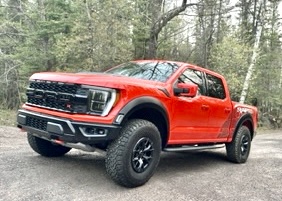
The new Ford Raptor R becomes king of the large-pickup hill with a high-tech 700 horsepower V8 out of the Mustang GT500.
By John Gilbert
There will never be another time when those of us in the business of reviewing new vehicles will have the sheer excitement of those days back about 1970, when factories competed with each other to build the most potent muscle cars to race each other in events like the Trans-Am road-racing series.
Back then, you could go to a showroom and select a Ford Mustang, Chevrolet Camaro, Dodge Challenger, Plymouth Barracuda, Pontiac Firebird, or American Motors Javelin, and approximate the thrills great drivers like Parnelli Jones, Mark Donohue, Dan Gurney, Swede Savage, Sam Posey and others gave us — and themselves — to battle for supremacy.
As a young reporter recently married and with a young son named Jack, we compared all of them for my road-test reviews in the Minneapolis Tribune, and decided to purchase a 1970 Mustang Boss 302, which had a specially-built 5-liter V8 that had solid valve lifters, a forged steel crankshaft instead of cast iron, and was the closest thing to a race engine in a stock, street vehicle. That 1970 Boss 302 was extremely quick, handled with instant precision and revved to over 6,000 RPMs. It also emitted a low roar that built until converting to a high-pitched whistle as you neared the red line.
The only place you can find contemporary manufacturers’ competition for all-out performance nowadays has transferred to pickup trucks, which shouldn’t be surprising, because pickups are the ultimate pure-American vehicle, and the top models from Ford, Chevrolet, Ram, Toyota and Nissan are trying every year to outdo each other to build the baddest, most imposing pickups on the planet.
For several years, Ford built a specialty off-road F-150 that started with a unique widened and toughened new frame for the best stability in the pickup world, and after adding all sorts of ultimate off-road features to upgrade its suspension, terrain-clearance, shock travel to climb the toughest terrain, and anything else imaginable, they named it the Raptor.
It also came with a reinforced 3.5-liter, dual-overhead cam V6 that was turbocharged to EcoBoost standards, and it was declared king of the hill(s). For $78,545, you could rule the roads, and the off-roads.
But then a couple years ago, Dodge sent its Ram division engineers off to build a more powerful rival to the Raptor, and with proper marketing flair designated the new Ram entry the TRX. Fitted with the monster 6.2-liter Hemi V8 out of the Charger/Challenger Hellcat models, the TRX developed 702 supercharged horsepower, which left the Raptor in its rear-view mirrors with “only” 450 horses.
Never mind that the Raptor still had a clear edge in refinement, comfort and compliance, the TRX gained the nickname “Tyrannosaurus Rex,” shortened to “T-Rex” by muscle-car zealots, perhaps unaware of the irony of what may be a dying breed of overpowering hot-rods.
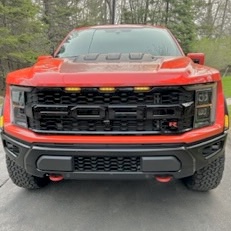
Active shutters aid air intake on the blacked-out Raptor R grille, with all its outlining accessory lights.
Regardless, the new challenge was not to be ignored by Ford, realizing the TRX could whip the Raptor by nearly a half-second from 0-60, registering 4.1 seconds in several tests.
Ford engineers went back to the drawing board, selecting the high-tech 5.2-liter dual-overhead-cam V8 they had built for the new Mustang GT500, and supercharging it up to 700 horsepower. That sounded like a near-miss, compared to the Ram’s 702 horses, but the Ford is significantly lighter, and, sure enough, the Raptor R now can beat the monster TRX by about 0.4 seconds from 0-60. Motor Trend listed the Raptor R’s 0-60 sprint at 3.7 seconds. It was a solid corporate victory against a Dodge power plant that appears to have reached its saturation point.
With 640 foot-pounds of torque backing its 700 horsepower, the Raptor R can scale cliffs in record time through its 10-speed automatic transmission, and those rocky terrain chunks it doesn’t clear will be pulverized by the heavy-duty skid-plates mounted under the raised body. The 700 horsepower peaks at 6,650 RPMs, while the stump-pulling torque needs only 4,050 revs to hit that peak.
For other dimensions, the Raptor R weights 5,960 pounds, with a length of 232.6 inches and a wheelbase of 145.4 inches. Its height is 80.6 inches, and its width is 87 inches. The width means you pretty well fill your driving lane, as well as ay parking spots you may find, but the height is another factor for drivers and passengers, because while it might be easy for a high jumper or pole vaulter, it is greatly aided by a lightweight but strong aluminum running board, finished in a pebbley black material not unlike the spray-in bedliner stuff to prevent slipping when winter brings ice and packed snow onto that running board.
Once inside, the black leather Recaro bucket seats are fantastic, cementing you in place if you’re bouncing around avoiding potholes or tackling Moab, or for just supportive comfort on a trip or for daily driving.
The sticker price is sticky, because all those heavy-duty features are after-market parts are blended with the contemporary safety devices to keep you in your lane and alert you to exterior vehicles and people and the price rises from the test vehicle’s base price of $109,145 to an as-tested price of $109,760.
That includes all the features, and the flashy Code Orange Metallic paint scheme with its black graphic package, and the blackened grille with its active shutter system.
If the price puts it out of your price range — maybe far, far out of your price range — consider that you’re paying a little extra for the imposing look of the Raptor R and for obtaining the baddest pickup truck in your neighborhood.
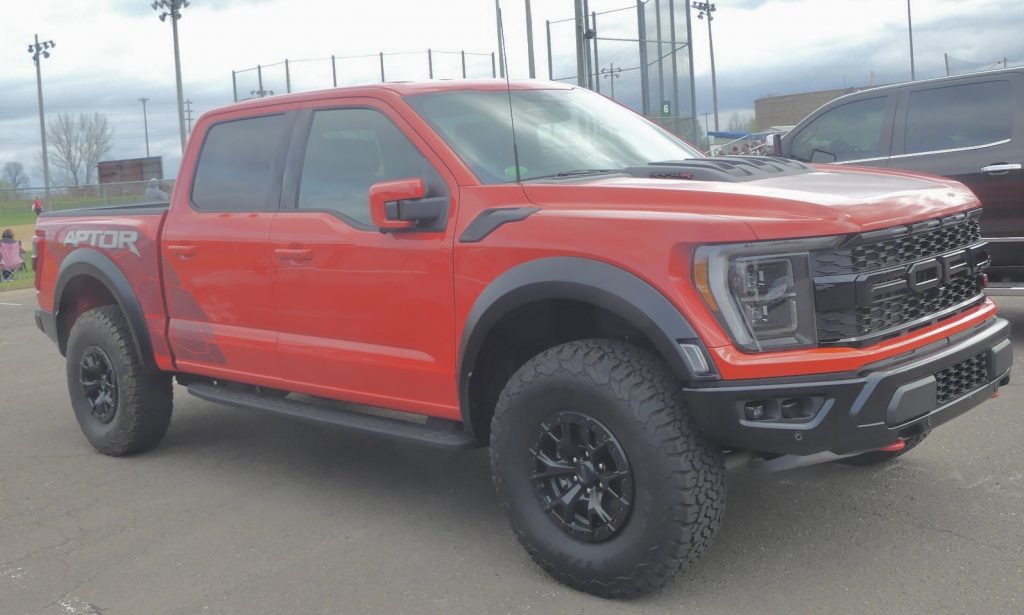
With all the impressive features of the super-wide Raptor R, there is also that high-pitched — and programmable — engine sound.
And here’s an extra inducement: When you start up from a stop and have only a small opening to enter the freeway, you hit the gas pedal hard and you can be treated to one of four selectable exhaust sounds, up to and including the “Sport” setting, which, I swear, goes from a hearty roar as you rev it up to 6,000 revs where it changes into what can only be described as a 1970 Boss 302 whistle!
The only thing better than muscle-car muscle is high-tech muscle-car muiscle.
Sleeker Tiguan combines assets of sedan, SUV
Filed under: Weekly test drives, Autos
By John Gilbert
Back when the Tiguan came out as a new idea for a utility vehicle from Volkswagen, the conservative builder of dependable compact cars like the Golf, Jetta, upscale to the Passat, and the venerable old
Microbus, it seemed to be a curious notion.
Little did we all realize the craze that would follow, with consumers throughout the U.S., and later all around the auto-buying world clamoring for more SUVs until they are now threatening to squeeze normal cars out of the marketplace.
I recall those first Tiguans, because they were loaded with utility, but they were sort of tall and squarish vehicles. Years later, VW added a longer version of the Tiguan for more room and more occupants. When that came out, I appreciated the shorter and more agile shorter version — just because in nearly all circumstances, I prefer the more compact length, but having room for a third row of seats was a family feature.
When the 2023 version of the Tiguan arrived at my house in Duluth, Minnesota, for a week-long test, I first thought it was a wagon version of the Passat or Jetta. No longer was it taller and squarish, but seems to be lower and sleeker in a modernized way that made it enticing to drive. I had to keep rethinking that it was, indeed, a Tiguan, with the benefits of driving agility and three rows of seats that somehow fit inside.
As usual, Volkswagen has made evolutionary moves with the Tiguan rather than revolutionary changes. For styling, the redesigned exterior is subtle, with a new wraparound grille that encompasses the LED headlights as part of its wraparound plan. The foglights are LEDs, too, for maximum brightness and sharp visual cutoff of that brightness.
Otherwise, VW brought the Tiguan up to contemporary elite status by revising the interior with improved seats, a restyled dashboard with an enlarged information display that can be changeable to show you climate, audio, and all other useful information for your drive.
Under the hood, the tried and true Volkswagen 2.0-liter gas 4-cylinder has taken inspiration from the GTI, that timeless hot rod in a small compact that has enthralled performance buyers and drivers for decades. Refining that engine over the years has pretty well perfected it, and adding a turbocharger means you have 184 horsepower at your disposal, with the potent power of 221 foot-pounds of torque, and an 8-speed transmission moving the vehicle with quickness and agility.
That doesn’t mean the Tiguan is a hot-rod, because it is significantly heavier than the Golf or GTI, but it does move well for its size. Volkswagen does a lot better with its technical refinement than it does with its nicknames, in my opinion, however.
The car I tested was the “Tiguan 2.0T SE R-Line Black” model, which would imply it was probably painted black. But no, it was a bright Opal White Pearl paint, which means to be fully accurate you should say it’s a 2.0T R-Line Black model in white. The Black version has blacked out painted grille and alloy wheels, which add distinctly sporty appearance, while the R-Line adds some performance enhancements and trim upgrades.
Those refinements boost the base price of $32,950 up to $34,640, which is a bargain when you evaluate all it has with its competition. All the new safety gizmos are included, such as brake assist, electronic stability control, electronic differential lock, blind-spot assist, lane-keeping assist, pedestrian alert and prevention, stop-start, and a hill-holding concept that prevents you from rolling when you’ve stopped on a steep grade.
The overriding safety of the Tiguan is bolstered by the strong German tradition of build quality and solid feel, something which simply gives you the feeling you’re encased in a solid shell against intrusions by other vehicles. The steering quickness and firm suspension is further confidence-inspiring.
The firm comfort of the front buckets and the 3-person second row still leave you surprised that there’s a fold-down third-row seat that is best limited to youngsters, even though teens or adults would be comfortable back there for short hauls.
Al those features are enough to keep you checking the name on the hatch lid to make sure you have a Tiguan, and not a Golf or GTI that outgrew its livery. And who knows? Maybe next year they will come out with a Tiguan White model that comes in black.


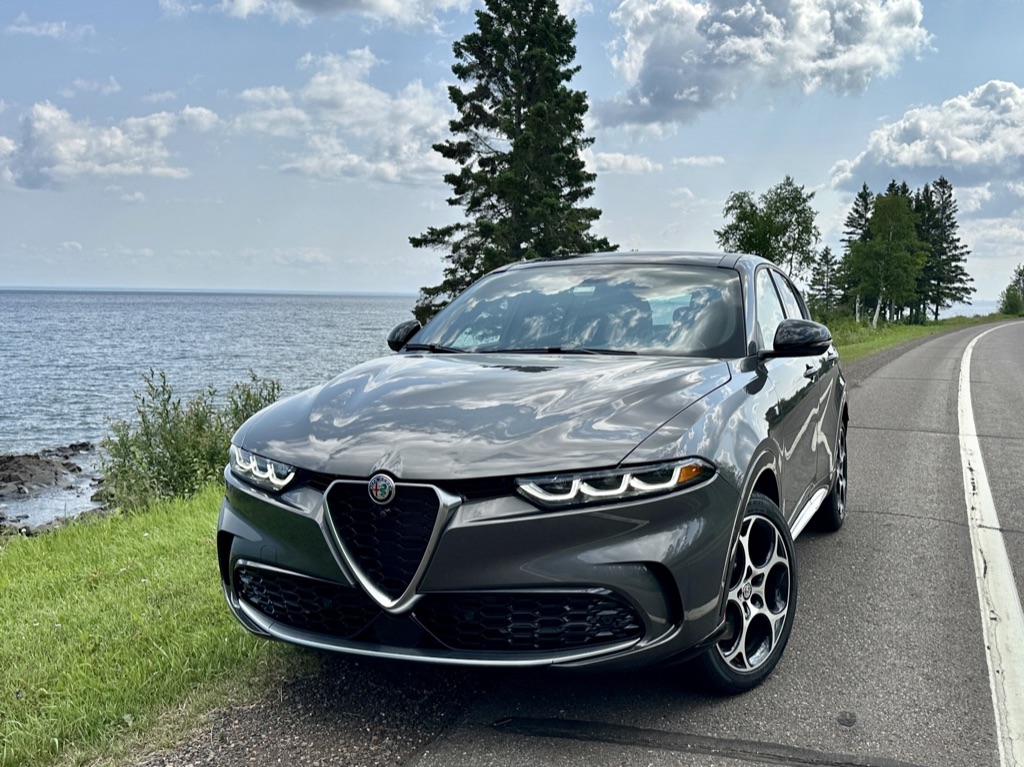


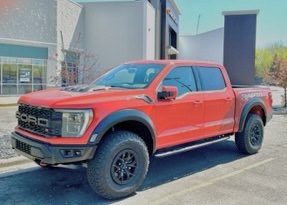

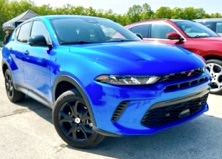


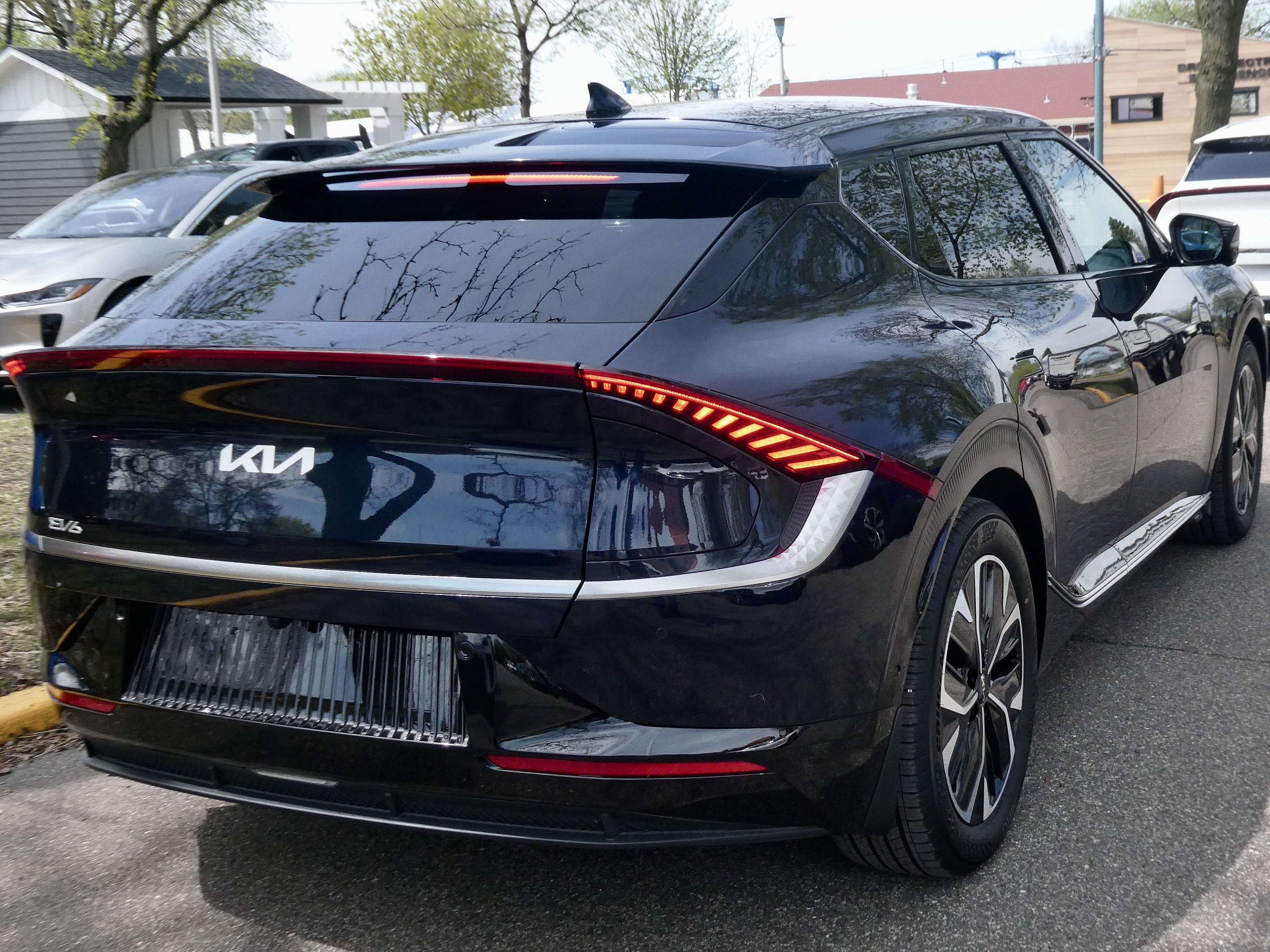
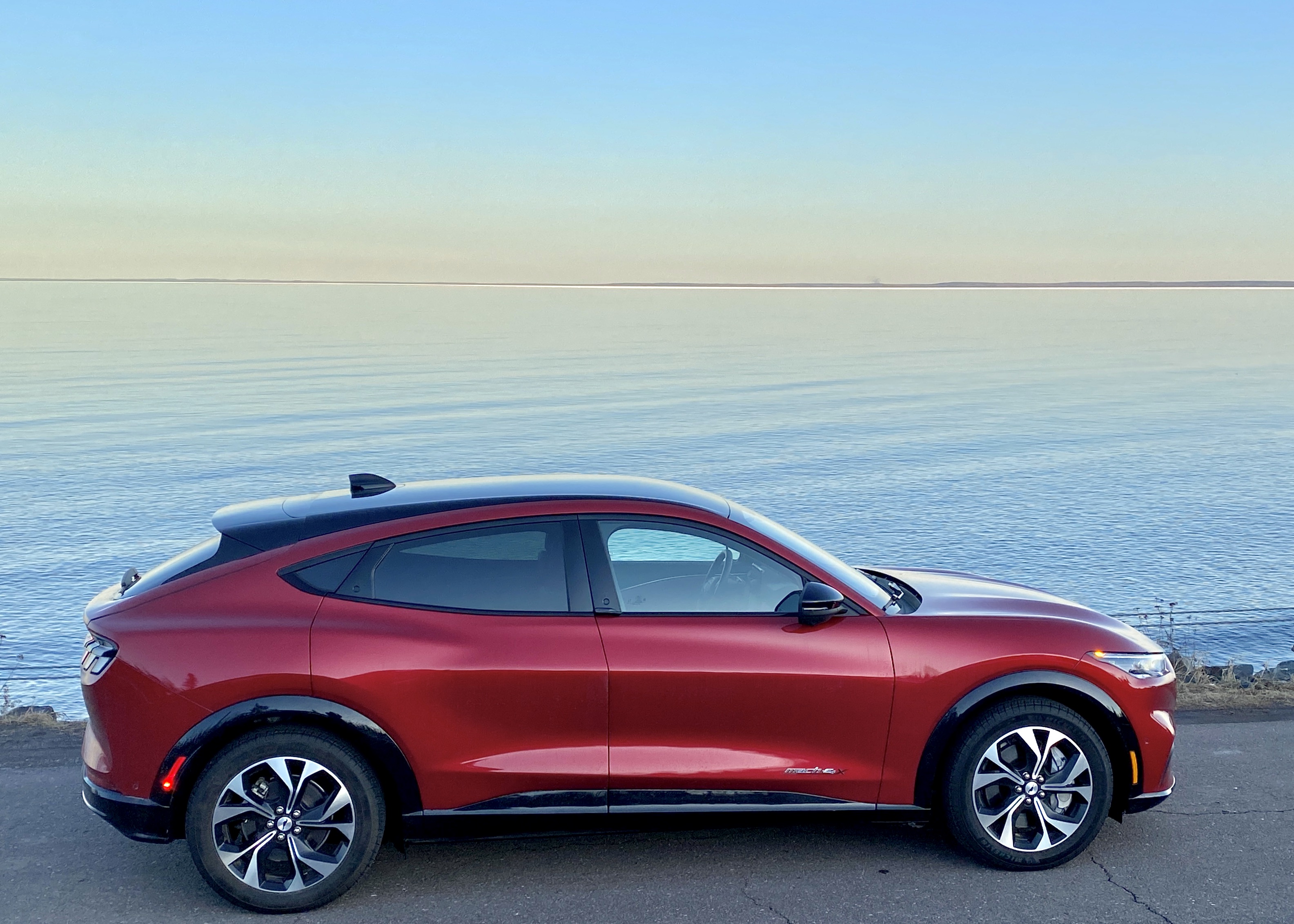

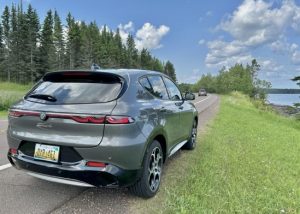
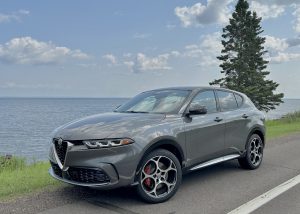

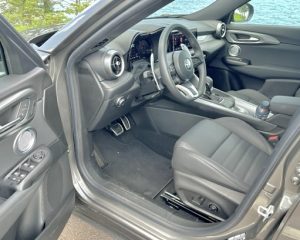

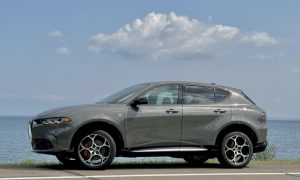
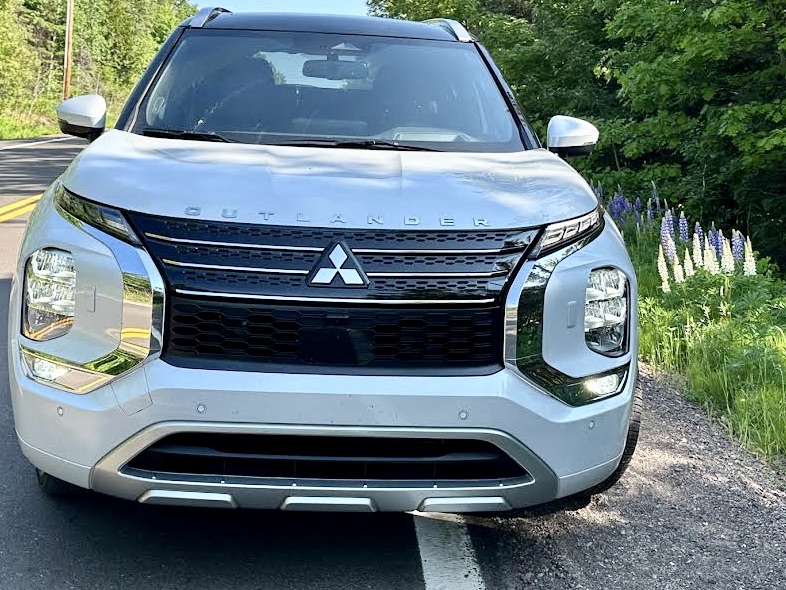
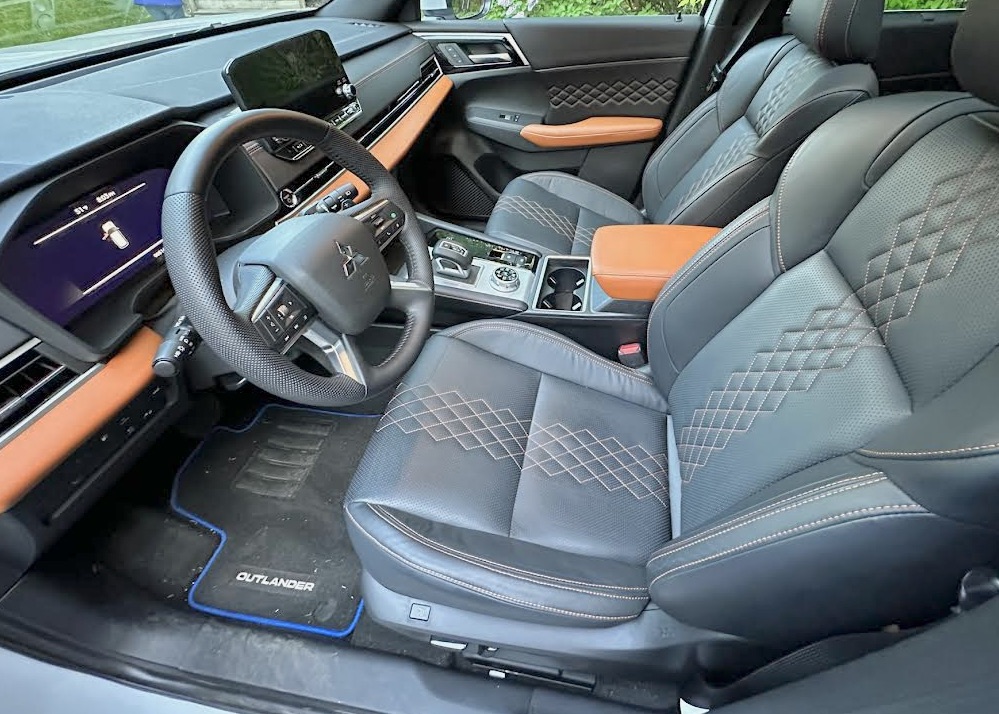
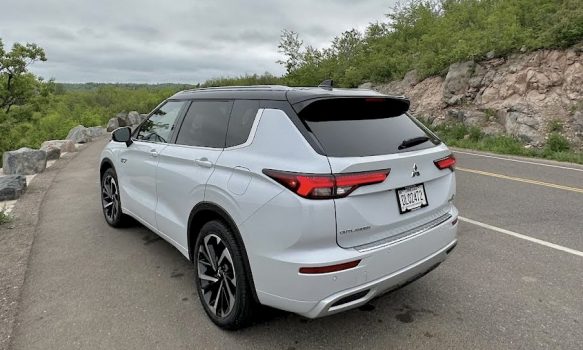
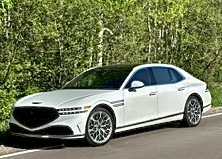
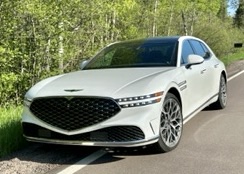
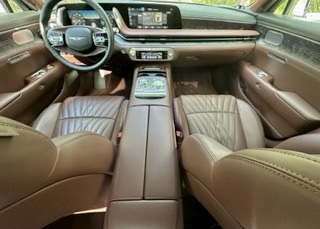
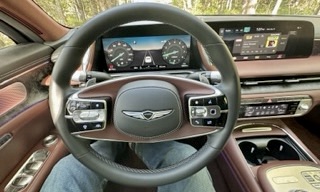
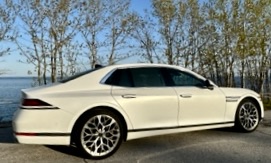
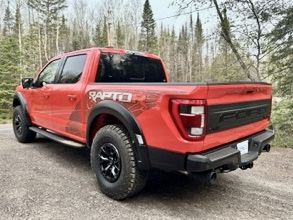



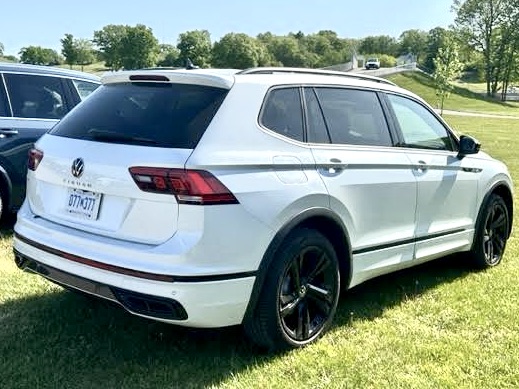
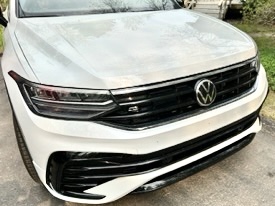
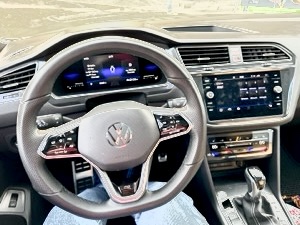
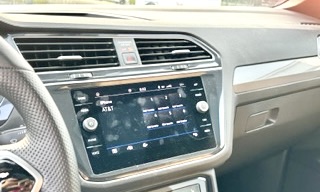
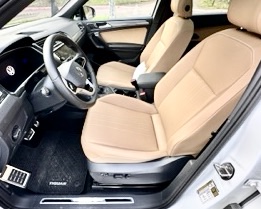
 John Gilbert is a lifetime Minnesotan and career journalist, specializing in cars and sports during and since spending 30 years at the Minneapolis Tribune, now the Star Tribune. More recently, he has continued translating the high-tech world of autos and sharing his passionate insights as a freelance writer/photographer/broadcaster. A member of the prestigious North American Car and Truck of the Year jury since 1993. John can be heard Monday-Friday from 9-11am on 610 KDAL(www.kdal610.com) on the "John Gilbert Show," and writes a column in the Duluth Reader.
John Gilbert is a lifetime Minnesotan and career journalist, specializing in cars and sports during and since spending 30 years at the Minneapolis Tribune, now the Star Tribune. More recently, he has continued translating the high-tech world of autos and sharing his passionate insights as a freelance writer/photographer/broadcaster. A member of the prestigious North American Car and Truck of the Year jury since 1993. John can be heard Monday-Friday from 9-11am on 610 KDAL(www.kdal610.com) on the "John Gilbert Show," and writes a column in the Duluth Reader.